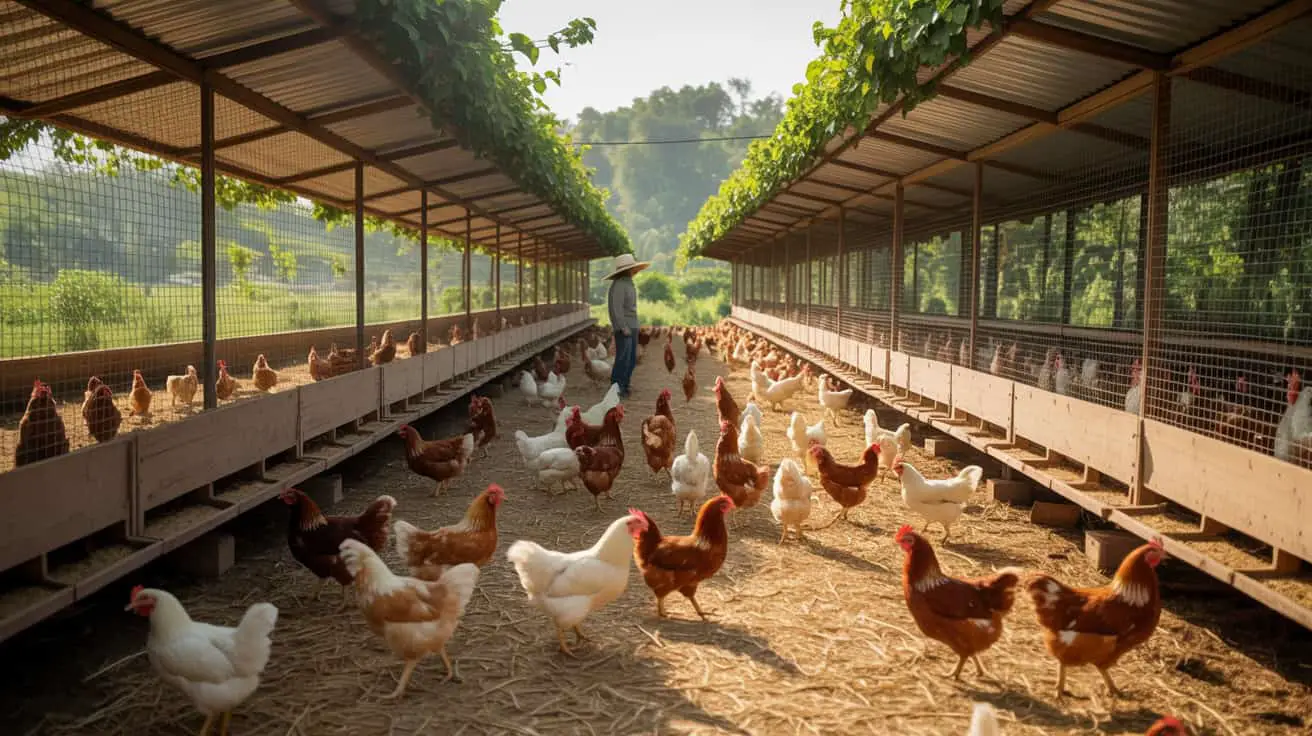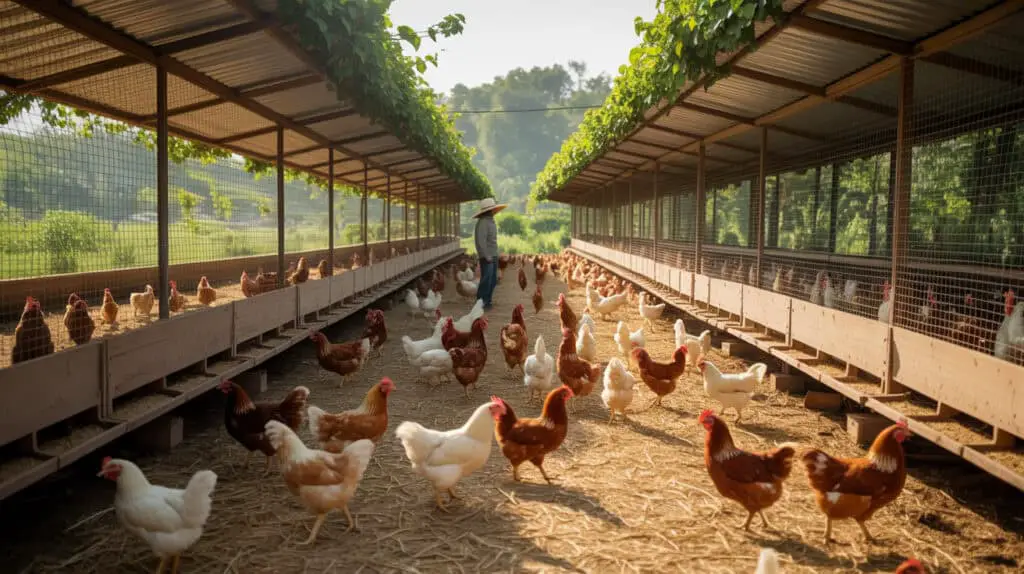
If you’ve ever looked at a big empty field and thought, “This could be something,” you’re halfway to starting a poultry farm. And if you’ve already got a few chickens scratching around your backyard, you’ve probably caught yourself googling things like poultry breeding pens with sliding doors or how big is too big for a chicken coop? Trust me, you’re not alone.
Starting or expanding a poultry farm doesn’t have to mean pouring thousands into custom buildings or hiring a consultant in a pressed flannel shirt. What it does mean is building a setup that works: a layout that’s manageable, scalable, and safe for your flock—whether you’re working with a quarter-acre behind the house or a full stretch of open farmland. Some people start with a garden coop and grow slowly, others go right into full-size poultry farm buildingswith walk-in space and separate zones for roosting, laying, and breeding.
1. A Classic Poultry Shed With Divided Roosting Zones
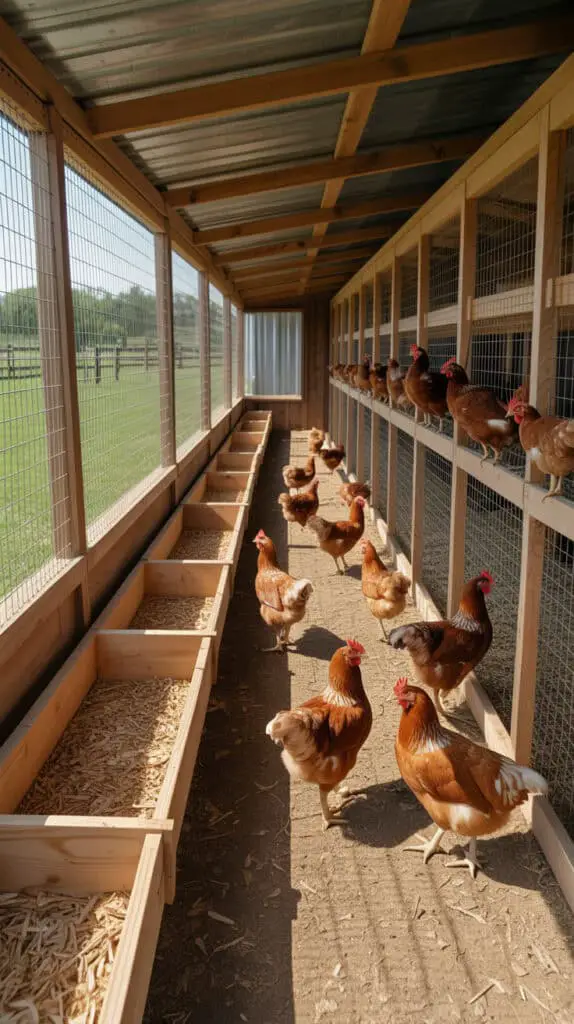
Start with the basics: a long, rectangular chicken shed made from wood or steel, divided into sections inside with wire partitions. This works for medium to large flocks and gives you flexibility to separate age groups or breeds. One end of the shed can be lined with nesting boxes and the other fitted with raised chicken roost ideas—wooden beams or staggered ladders that allow for airflow and easy cleaning underneath.
The floor can be packed dirt or concrete with bedding layered over top. Ventilation is a must, so install screened windows that can open in warmer months. You can leave one side open to a fenced paddock or rotate several paddocks as part of your free-range system. This type of chicken farming house is easy to maintain and leaves room for gradual expansion.
2. A U-Shaped Farm Layout With Central Feed & Water Access
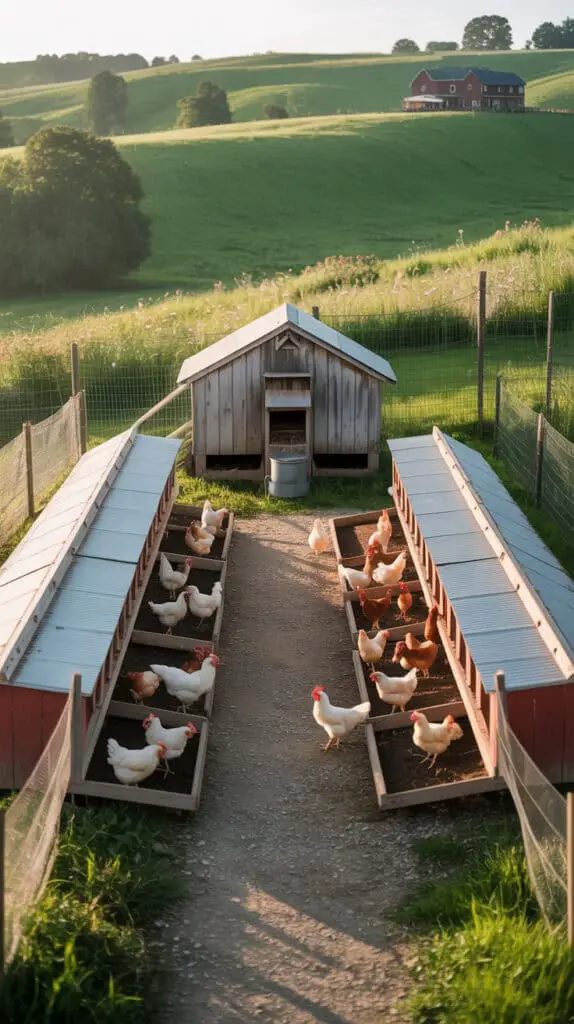
For farms working with a bit more space, a U-shaped poultry farm layout creates a natural flow between coops, feeding areas, and pasture zones. Position the chicken coops on either side of a central path with a feed and water station in the middle. It cuts down walking time, keeps everything organized, and makes morning chores way easier.
You can start with prefab coops and eventually build out long barns or custom sheds as your flock grows. Each leg of the U can be fenced to create alternating grazing areas for free range chicken coops, and the open middle can be used for tractor access, feed delivery, or seasonal shade tents. This layout works especially well if your poultry is part of a broader mixed farm setup.
3. A Converted Barn with Tiered Coop Interiors
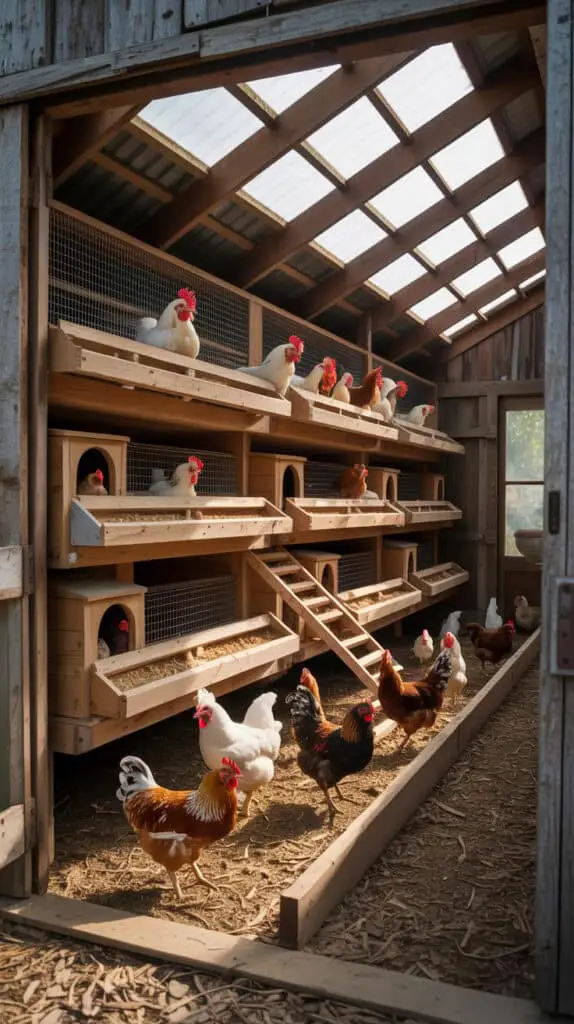
If you’ve got access to an old barn, that’s gold. You can section off part of the lower level as a dedicated poultry zone with a high ceiling for ventilation and plenty of roost space. Build interior frames with recycled wood to create chicken coop interior ideas that stack—lower levels for nesting, mid-levels for resting, and higher beams for roosting at night.
Make sure light can get in—translucent panels in the roof or large barn doors work great. This setup gives you a true large chicken coop idea without needing to build everything from scratch. Keep the floor bedding deep for insulation and easy cleanup, and consider separating the barn by age group or breed with sliding gates.
4. A Green-Patch Coop Rotation System
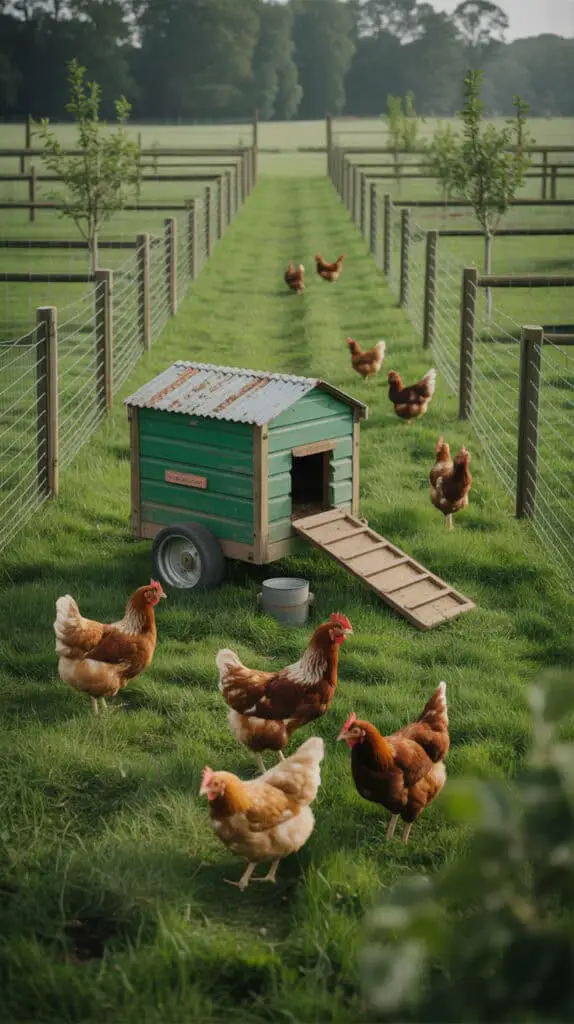
If your priority is keeping chickens on fresh grass without overworking the land, a rotational grazing plan can help. Divide your land into zones with fencing and move your coops or chickens through those zones weekly or monthly. This style of poultry farm design keeps soil healthier, reduces disease buildup, and keeps your chickens happily scratching.
You can use small mobile coops (chicken tractors), or build larger fixed coops at the center of each patch with walkways leading out. Each coop should still have shelter, nesting boxes, and some covered space. Add a few fruit trees or shrub lines between zones for shade and wind protection, and your pasture starts working double duty as both food and shelter.
5. A Backyard-Inspired Poultry Farm Near the Main House
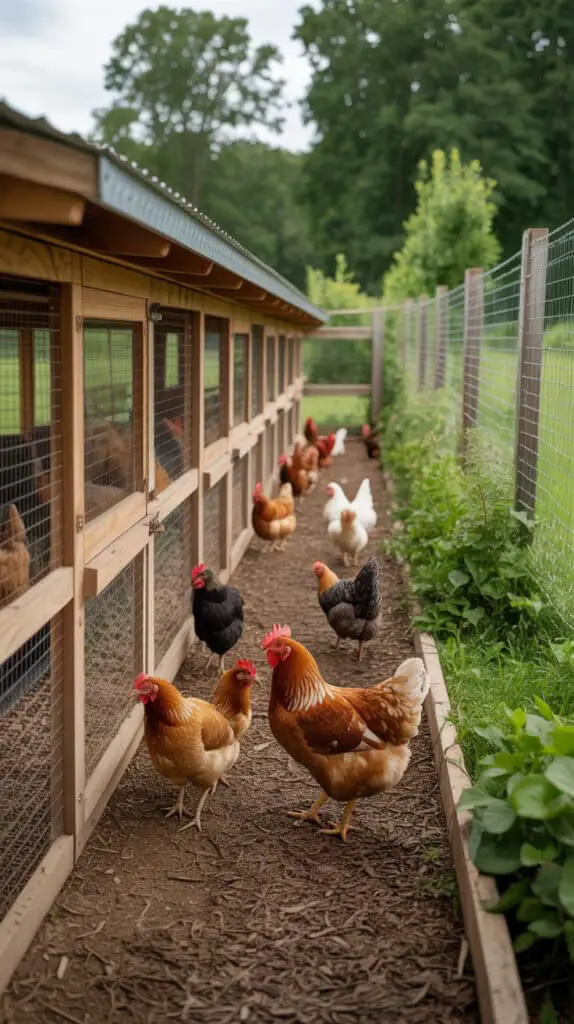
Some folks don’t have time to trek across the field twice a day, especially in winter. A chicken coop garden setup near the main farmhouse or homestead can bring your poultry into easier reach. Use a portion of the garden plot, orchard, or even a wide side yard to create a clean-lined, garden-style poultry area that feels more like an extension of home than a separate farm.
Build a few medium-sized coops with attached runs and arrange them along a mulch path or gravel walkway. Add a few climbing plants or wooden fencing to soften the look. You can still raise dozens of hens this way—it just feels a little more domestic. Plus, the closer they are, the more likely you are to notice if something’s off (like a missing water bucket or one rogue hen halfway up the compost pile).
6. A Central Coop with Radiating Outdoor Chicken Runs
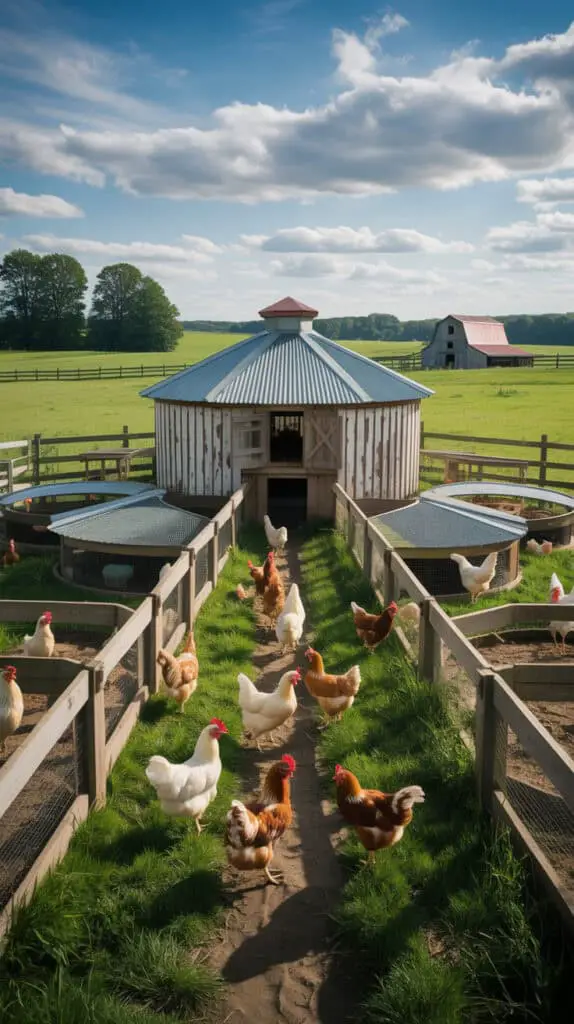
If you’ve ever looked at an aerial photo of a poultry farm and wondered why some look like spokes on a wheel, this is the idea behind it. You place a central walk-in coop—square or round—at the center of your space, then fence out several runs or pastures from that core. You can rotate your flock through these sections depending on weather, grass condition, or just to give areas time to recover.
This is a smart way to manage land while keeping everything within view. The central coop can be a traditional wooden frame or even a repurposed chicken shed. Inside, you’ll need multiple nesting sections and possibly layered roosting beams, depending on your flock size. You can add a small feed room in the back or even a second level for feed storage or future brooding pens. It’s efficient, tidy, and easy to expand just by adding more “spokes” over time.
7. A Long Narrow Coop for Sloped or Difficult Land
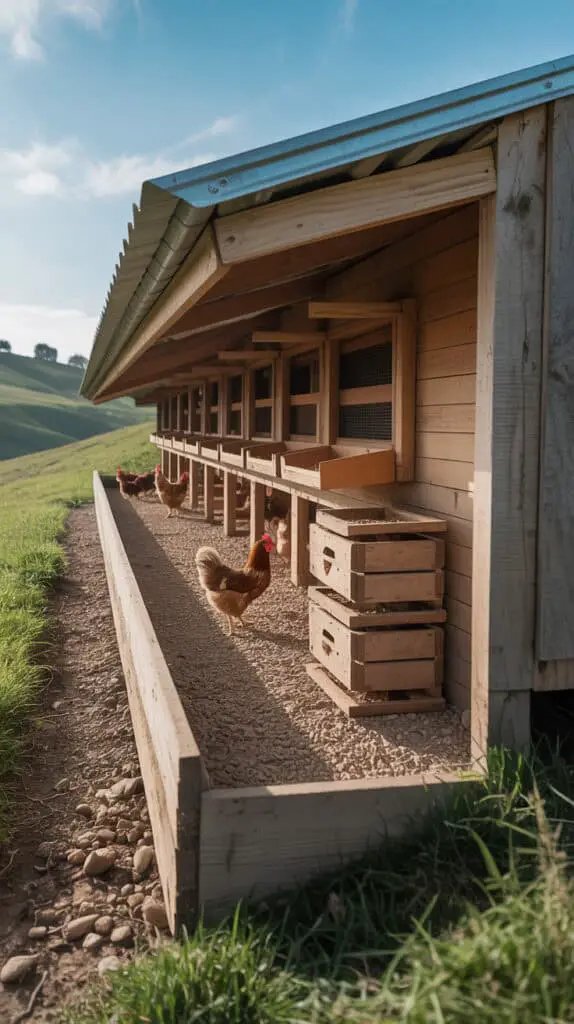
If your land isn’t a neat square of flat pasture, don’t worry—you can still make it work. Sloped land or odd-shaped fields are perfect for long, narrow chicken coops that run along the high side of the land and drain naturally. Use gravel or compacted dirt around the base to help with runoff, and raise the structure slightly off the ground if flooding is a risk.
These setups work well when built against a hill, especially if you add a sloped metal roof to collect rainwater for cleaning or feeding systems. The interior can be simple: one side lined with nesting boxes, the other with chicken roost ideas or stacked crates. Your outdoor runs can be fenced downward toward flatter areas, using the slope to your advantage for drainage and airflow. This kind of chicken farm design proves you don’t need perfect land—just a bit of planning.
8. Multi-Purpose Poultry Farm Buildings With Storage Space
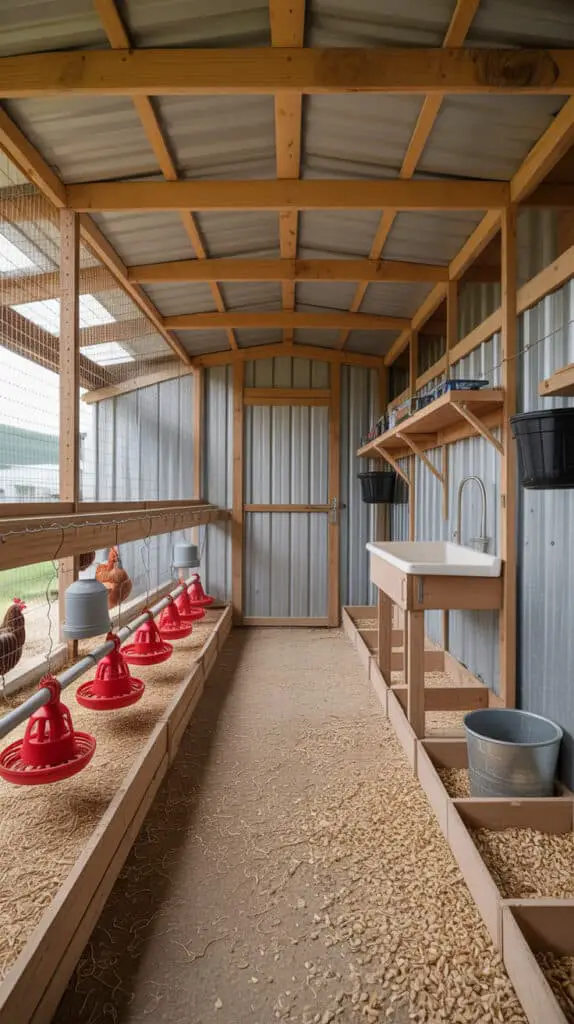
At a certain point, you’ll want a structure that does more than just house the chickens. A multi-purpose poultry barn lets you combine indoor coop space with feed storage, equipment shelving, and a space to clean eggs or prep bedding. Build one long structure and divide it into sections—a coop on one end, storage in the middle, and a dry work area with counter space and a sink at the other.
If you’re building from scratch, start simple: pressure-treated posts, metal siding, and a walk-in layout that allows airflow front to back. Inside, use hooks and bins for your tools and feeders. You’ll thank yourself later when everything from your extra waterers to your shovel is right where it needs to be. A setup like this is ideal for medium farms and backyard farmers scaling up into true poultry farming.
9. Breeding and Brooder Zones for Layer Expansion
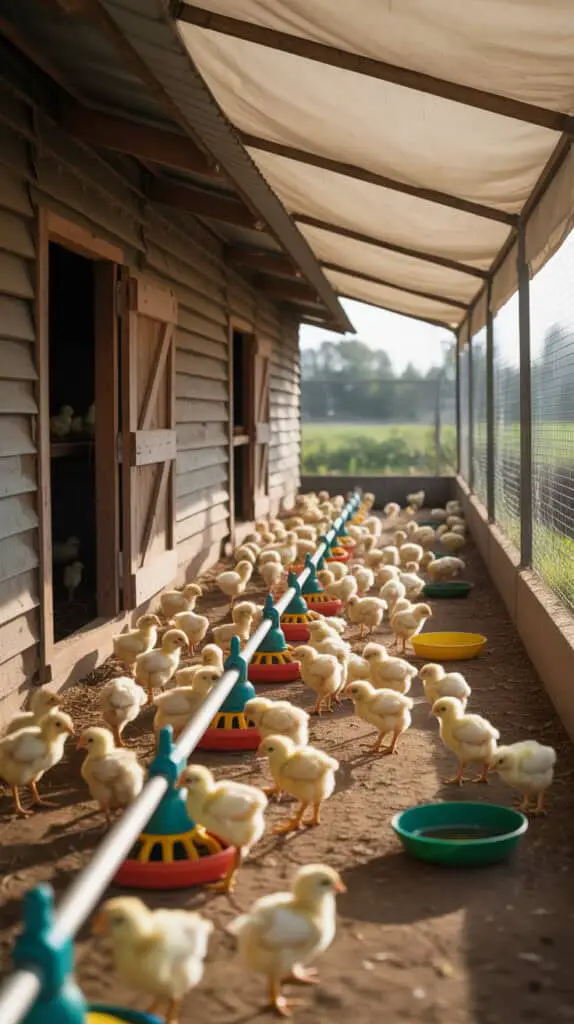
If your farm includes breeding, you’ll need dedicated zones for broody hens, chicks, and separate pullet areas. Start with a quieter space away from the main coop and build a few small structures for poultry breeding pens. These can be low-profile coops with deep bedding, insulated walls, and minimal light. Each should have a secure outdoor section with shade and cover, ideal for young chicks or hens with a clutch.
Add a brooder building nearby or in an attached wing—a small insulated room with lights, chick feeders, and bedding ready to go. It doesn’t have to be huge, just easy to clean and separate from your main flock to avoid stress and disease spread. Having this kind of layout in your poultry farm buildings means you can raise new generations year-round or scale up when needed.
10. Open-Air Coop Rows for Warm Climates
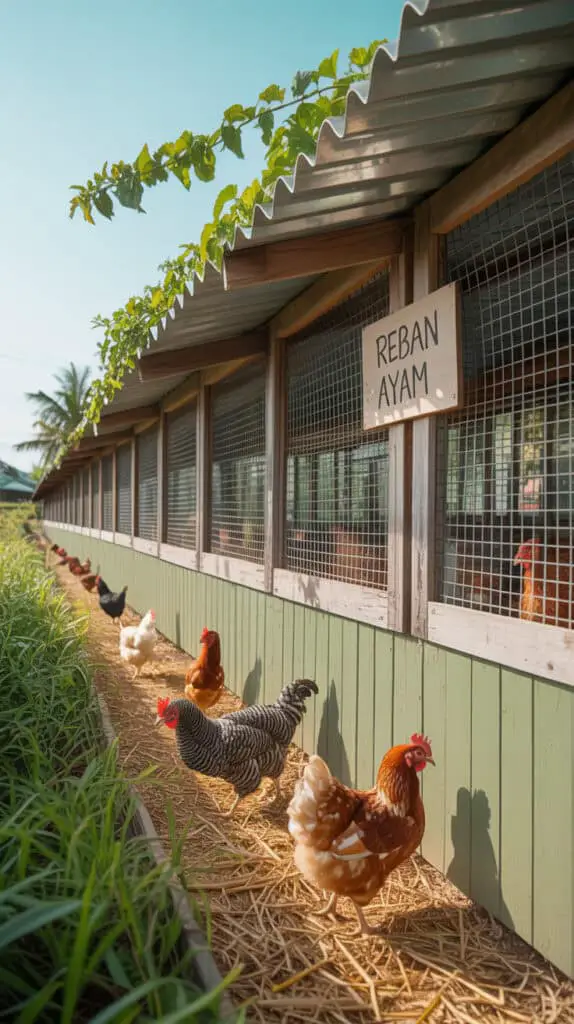
If you’re farming in a place where it’s warm most of the year (or just very humid), a fully enclosed coop might be more of a hassle than a help. Instead, build open-sided coop rows with a sturdy roof and wire walls—like a carport, but for chickens. The ventilation helps prevent moisture buildup, reduces smell, and makes cleaning much easier.
Line the roof with a reflective material or grow vines over the top to add shade. Include solid wooden panels on the lower half of each wall for privacy and wind protection, and line the ground with straw, sand, or gravel. Each row can be divided into flocks and extended over time. These types of reban ayam setups are popular in Southeast Asia, and with good reason—they’re budget-friendly, functional, and naturally cooler.
Final Thoughts
Building a poultry farm, whether it’s in your garden or across a few open acres, really comes down to planning what works for your land, your lifestyle, and your hens. You don’t need the fanciest structure or the biggest setup—you just need something solid, safe, and flexible enough to grow with you.
Whether you’re converting a shed, laying out multiple grazing runs, or drawing up your own DIY chicken coop plans, the real joy is watching your chickens thrive in a space that fits you both. Keep it affordable, practical, and a little bit charming—and you’ll find yourself loving the process just as much as the eggs.

